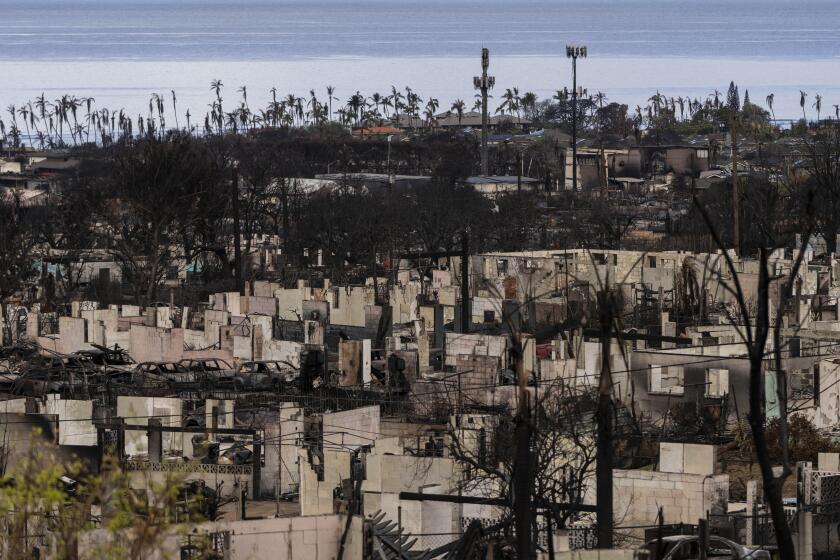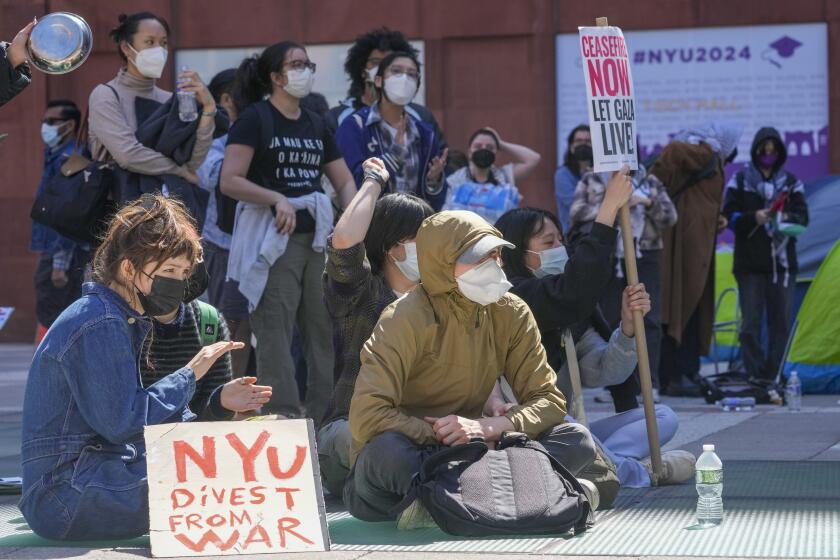Peace Corps Faces Issues of the ‘90s : Foreign aid: English lessons may include an AIDS warning set to the rhythms of rap music. But the agency’s basic concept remains, that idealistic Americans can make a difference.
The new Peace Corps is the rap rhythms of an English teacher in Cameroon, an instructor in business management in Ukraine or a volunteer in Honduras seeking to slow destruction of the rain forest.
Don’t let anyone accuse the Peace Corps of being stuck in the 1960s.
The New Wave approach is best embodied by Thurman Matthiesen, something of a legend around the agency for his pioneering ways.
Conjugating verbs and demystifying the past perfect tense was not Matthiesen’s style. Instead, he used English class in Cameroon to teach AIDS prevention, and he got the message across with the rhythms of rap music.
A videotape shows Matthiesen standing before his class of about 30 in the northern town of Ambam, his ponytail wagging behind him. The lesson, replete with rap gyrations, begins:
“AIDS is like a murder blade. It kills you dead, man. You’ll never raise your head. Buried in a grave, no more talkin,’ no more walkin,’ lungs breathin’ dirt.”
The students love it.
In Peace Corps parlance, Matthiesen is using a “cross-sectoral” technique. It’s a two-for-one deal: the students get English and a lesson in the dangers of sexual intimacy.
Matthiesen, 29, a native of Washington, D.C., ended his Peace Corps service two years ago, but his rap compositions have become part of the English curriculum in Peace Corps programs in Cameroon.
Even as the Peace Corps adapts to the times, its foundation remains remarkably unchanged--the notion that idealistic Americans can make a difference.
When John F. Kennedy first proposed the Peace Corps in the 1960 presidential campaign, opponent Richard M. Nixon derided the idea as a “kiddie corps.” But now, 34 years and 140,000 volunteers later, the doubters are on the defensive.
A recent University of Maryland poll nationwide said 90% of Americans support maintaining or increasing Peace Corps funding levels. The most budget-conscious Congress in history is expected to leave the agency’s $231-million budget largely intact. Eight Peace Corps alumni are in Congress, evenly divided among Democrats and Republicans.
When the first group of volunteers arrived in Kazakhstan a few years ago, President Nursultan Nazarbayev said, “A hundred volunteers is not enough. I would like to see thousands here.” When Ethiopia’s first post-Communist president visited the United States, he asked for volunteers; he had been taught by one as a youth.
These days, there is a focus on environmental programs. In more than half of the 93 countries where the Peace Corps operates, volunteers work in reforestation and forest management. In Costa Rica, Guatemala and Honduras, there are efforts to slow destruction of rain forests. Elsewhere, volunteers incorporate environmental issues into math and science lessons and English language programs.
The teaching of business skills is becoming a Peace Corps staple. In Honduras, volunteers are teaching cocoa processing to reverse the pattern of sending locally grown cocoa abroad for processing and then coming back for local consumption.
When communism collapsed, the Peace Corps moved in quickly--too quickly, some say--to the former Soviet empire. Under pressure from the George Bush Administration, the agency blundered badly, no more so than in the barren steppes of Uzbekistan in Central Asia.
The General Accounting Office, an arm of Congress, reported last year that half the volunteers sent to Uzbekistan left the program the first year. Of those who remained, more than half were transferred from their original sites because of harassment by the local population. In Russia, volunteers complained that they were stymied by a lack of money, books, office space, telephones, computers and other equipment.
Frederick O’Reagan, who manages Peace Corps programs in formerly Communist countries, says those problems have been overcome and that the agency can’t meet the demand for volunteers.
He says even the most brilliant strategy would have been insufficient, given the challenge of trying to introduce marketplace values to a region that spent seven decades under Marxist rule.
“If we [in the United States] decided tomorrow to become a centrally planned economy, how many of us would know how to do it?” O’Reagan asked.
The emphasis on business development has changed the Peace Corps image. While boots, jeans and mud-hut abodes may still be in style in Latin America and Africa, the business suit is the standard in the former Communist countries. In Ukraine, when some volunteers arrived with informal wardrobes, arrangements were made to have business suits sent from home via diplomatic pouch.
Volunteers help develop business clubs and chambers of commerce, create credit unions, and give advice on marketing and bookkeeping. They help local firms find foreign aid. Local affiliates of American and other foreign firms look to the Peace Corps for aid with personnel training and advertising. In Ukraine, volunteers teach entrepreneurship through their own television shows or newspaper columns.
One of the bigger problems of the ‘90s is increased crime and ethnic violence. In Jamaica, three years ago, 18 volunteers were mugged in a six-month period. Civil strife has forced termination of Peace Corps programs in Rwanda, Burundi and other countries.
In Uzbekistan’s male-dominated society, Peace Corps women sometimes are followed by stalkers and are the target of lewd comments or, in at least one case, rape. In one incident, a volunteer was followed by a man on a bicycle who was exposing himself. In another, two women were chased and beaten. One quit the Peace Corps and the other transferred to another city.
In the worst known case, a woman was grabbed by three young men. She escaped into the arms of a young couple, who took her to their home and robbed her. She escaped again and ran to a police officer, who refused to leave his post. Instead, he turned her over to a male passerby--who raped her and fractured her skull. That victim, Kathleen Cummings, went public with her ordeal to warn others.
In the early Peace Corps, the average volunteer was in his early 20s. There’s a grayer look nowadays, especially to the recruits peddling business skills. Their average age is over 40, and most have masters degrees and more than 10 years’ business experience.
About 10% of the 6,500 volunteers are over 50.
Among them is Loretta Land, 61, from Cleveland, who left this spring for an assignment in Armenia. After rearing eight children, she became a receptionist a decade ago and rose to become assistant vice president at a large bank. She was attracted to the Peace Corps because she wanted to make a difference in people’s lives, an experience the corporate world normally does not offer, she said.
“They are looking for people who can think out solutions,” she said. “If you have only the ability to follow, you’ll have trouble in the Peace Corps.” Land is planning to write daily letters to her nine grandchildren from Armenia and convert the correspondence into a book on her return. The title: “Grandma Is Going Where?”
In cultures where age is revered, older volunteers have an advantage. But youth is a plus in the Cameroon AIDS project, where students can relate better to a youthful mentor like Matthiesen, the rap practitioner.
Use of rap may smack of frivolity, but it is part of what appears to be a meticulously planned effort to get Cameroonian students to pay heed to AIDS’ dangers. Three-quarters of all reported AIDS cases have occurred in Africa, and the 15-24 age group is by far the hardest hit.
“1, 2, 3, 4, and 5, 6 and 7, even 11 years AIDS can live before killing you,” Matthiesen chants. “And during that time, that infectious state, everybody you make love with will have the same fate. To die in a miserable way.”
More to Read
Start your day right
Sign up for Essential California for news, features and recommendations from the L.A. Times and beyond in your inbox six days a week.
You may occasionally receive promotional content from the Los Angeles Times.






